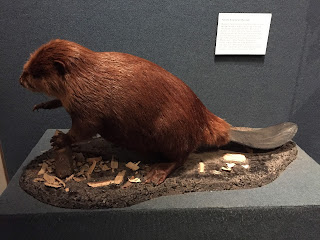 |
| Routes to Mackinac Island |
 |
| Records kept by the American Fur Company |
 |
| Voyageurs |
Connected by narrow straits, three of the five largest Great
Lakes, Huron, Michigan and Superior converge near Mackinac Island. Located
amidst these waterways, the Island and some of its surrounding shores served as
a base for exploring and, later, for
developing an expansive fur trade in the Great Lakes.
In the 17th century, the French claimed the
territory surrounding the Great Lakes. At this time, their Jesuit priests and
explorers paddled up the Ottawa River from Montreal, eventually making their
way through Lake Huron’s Georgian Bay and then on to Superior and
Michigan. Some even canoed through
Lake Michigan to the rivers of Wisconsin and with a short portage made their way to the Mississippi River.
What drove people to undertake these life-endangering expeditions?
The very earliest explorers, like
Samuel de Champlain, were searching for a new route to China that would enrich
themselves and the French nation. For priests like Father Jacques Marquette, the answer was
clear: saving souls by bringing the Indians the sacraments of the Catholic
Church. For the voyageurs like Jean Nicolet, the response was a search for
adventure and fortune.
The lands and waterways surrounding the Great Lakes were
rich with fur bearing animals – such as beaver, marten, lynx, mink, otter,
bear, and fox. Once the Indians learned what the Europeans had with them – knives,
hatchets, cooking pots, muskets — they sought to acquire these modern metal
items. Local Indians brought the highly valued pelts to the trading post on
Mackinac Island where the exchange of goods took place. Each side had a clear incentive and therefore trade
flourished.
Control of these great northwestern territories shifted
from French, to British, to American. After the French and Indian Wars,
1756-63, sovereignty was transferred from France to Britain. Soon thereafter,
with the Treaty of Ghent ending the War of 1812, the boundaries were settled between
the United States and Great Britain/Canada as large parts of the Great Lakes came
under the American flag.
 |
| Mackinac Strait Suspension Bridge, i.e. Big Mac |
There was strong competition to benefit from the wealth of the fur
trade. In 1809, John Jacob Astor organized
the American Fur Company in order to challenge the British monopoly that
extended from the Great Lakes to the Pacific Northwest. Astor was a remarkable entrepreneur. In addition to establishing a trading fort in Astoria,
near the mouth of the Columbia River, to compete directly with the Hudson’s Bay
Company, he traded along the Missouri River to the Rocky Mountains in the newly
purchased Louisiana Territory. On Mackinac Island in Lake Michigan, he established
a trading center and by 1822 held a monopoly on the Great Lakes fur trade.
At its Mackinac Island base, Astor’s American Fur Company,
set up a warehouse, dormitory, retail store and boat yard. A resident manager
was put in charge, while Astor himself never came to the island.
Astor became one of the richest men in the world of his time,
a credit to his entrepreneurial skills, some well-timed assistance from the
federal government in forcing out British competition, and finally, superb
timing of selling his fur business just as the European fashions shifted to
silk. After he sold out his
interest in the company (then a US monopoly) in 1834, he reinvested his wealth
in New York City real estate. John Jacob Astor was a man in the right place at
the right time, many times!
LAST BLOG IN VOYAGE THROUGH AMERICAN WATERWAYS.













































